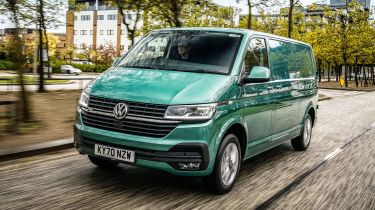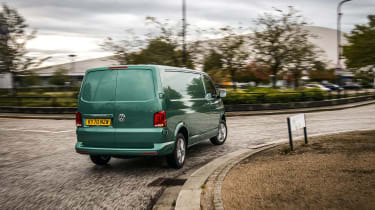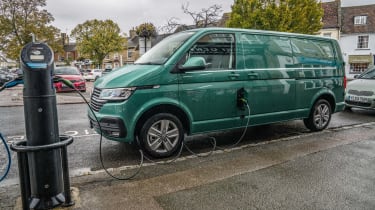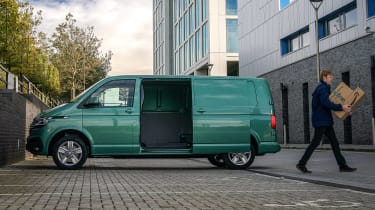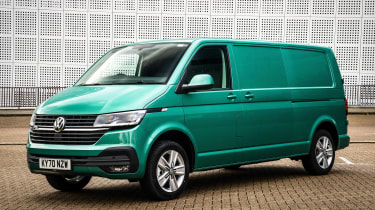Volkswagen Abt e-Transporter review
Volkswagen's sole electric commercial vehicle in the UK mixes the Transporter's impressive core qualities with EV efficiency, but watch that range!
In the race to get electric vans for sale on the UK market, the Volkswagen Abt e-Transporter T6.1 was a bit of a late arrival. It's not the first electric van from the company, because the VW e-Crafter was already offered in Europe. However, there are currently no plans to bring this larger model to the UK, and with the smaller VW Caddy being replaced by the Caddy 5, that means the electric Abt e-Caddy won't come here, either. In fact, the Abt e-Transporter is a bit of a temporary addition to VW's ranks here, because it meets short-term demand for an electric VW van ahead of the launch of the all-new ID.Buzz Cargo, which is due in 2022.
So what's the VW Abt e-Transporter T6.1 all about? Well, the Transporter T6.1 part of its name means it's based on the most recent version of VW's mid-sized van (the Mk6), which received revised looks and tech from the VW passenger car range in 2019 (the 6.1). The e- prefix is self-explanatory, while the Abt part of the name refers to VW's electric vehicle partner. Abt is a German company famous for offering aftermarket wheels and bodykits for Audis, SEATs and other VW Group models, and for running Audi's entry in the Formula E electric single-seater series. But it also has an EV department, which is responsible for building the e-Transporter and aforementioned Europe-only e-Caddy.
Abt takes engine-less Transporter T6.1s from VW's production line in Hanover and fits them with the electric running gear, which comprises a 108bhp electric motor and a 37.3kWh battery. This is a development of the system that was offered in the e-Golf, but that does mean it's tech that's slightly behind the curve when compared with rivals. As a result, the e-Transporter has a driving range of up to 82 miles, which isn't as long as some rival electric vans.
Used - available now

2020 Suzuki
SX4 S-Cross
46,548 milesManualPetrol1.4L
Cash £11,997
2020 BMW
X2
44,368 milesAutomaticPetrol2.0L
Cash £14,997
2021 SEAT
Ibiza
18,736 milesManualPetrol1.0L
Cash £14,897
2023 Land Rover
Discovery
13,183 milesAutomaticDiesel3.0L
Cash £57,500Charging is handled via Type 2 and CCS charging ports which are located where the diesel fuel filler is on the diesel Transporter. AC and DC charging is available, with a maximum current of 50kW DC accepted. Plug into an appropriate source, and an 80 per cent charge from flat can take around 45 minutes, while charging from a 7.2kW wallbox sees the battery fully charged in around five and a half hours.
The electric motor is connected to a modified version of the DSG twin-clutch gearbox that's available with the Transporter diesel, and it sends power to the front wheels. Thanks to the layout of the e-Transporter's electric drivetrain, cargo volume is the same as you'll find in the diesel version, and in the long-wheelbase panel van body, there's 6.7 cubic metres of space on offer. The only other body option is the five or six-seat e-Transporter Kombi, which is based on the same long-wheelbase platform.
Prices for the Abt e-Transporter start from around £42,000, which is more than you'll pay for the Vauxhall Vivaro-e, which has a far longer driving range. But the e-Transporter is a classy van with a decent interior and spec list that's refined to drive.
Energy use and running costs
As with any electric vehicle, the VW Abt e-Transporter T6.1 has a relatively high initial purchase price, but everyday running costs will be rock-bottom because charging the battery is far cheaper than filling with diesel. You're looking at a starting price of around £42,000 for the long wheelbase panel van (the only length available), while going for Advance trim adds around £3,500 to the price. Go for the e-Transporter Kombi, and you can add another £4,400, so the top-spec Kombi Advance is in the region of £50,000.
The savings are made on day-to-day costs, with zero road tax, cheap recharging costs, lower servicing bills and exemption from low emission zone charges helping to reduce the total cost of ownership over the life of the van.
At launch the e-Transporter was available with a 3-for-2 servicing offer costing £399, which covered the van's first three services, first MoT plus pollen filter and brake fluid replacement. Service intervals are annual or every 24,900 miles (whichever comes first) with an extended inspection at 36 months/74,500 miles. After that, the extended inspection takes place every two years.
VW quotes a WLTP range of 82 miles for the e-Transporter, while our time with the van revealed that this is the sort of range you can expect from a full charge. However, as with all EVs, if you spend more time driving at higher speeds, you'll see the range drop, although a speed limiter that restricts the van to 56mph is fitted as standard to help maintain battery range.
That 82-mile range is likely to be enough for a day's work, but rival electric vans can go even further on a charge. The Mercedes eVito has a quoted range of 95 miles, while the Vauxhall Vivaro-e (as well as its Citroen e-Dispatch and Peugeot e-Partner siblings) has a maximum quoted range of 205 miles - these three are cheaper to buy in the first place, even if you go for the big 75kWh battery variant. Like the e-Transporter, we've found that these vans all deliver real-world range that is similar to the WLTP-quoted figures.
Load space and practicality
Retrofitting the Transporter T6 with an electric drivetrain hasn't affected its cargo volume. There's 6.7 cubic metres of space, the same as you'll get in the diesel long-wheelbase van. It's a shame that there's just one panel van variant, but seeing as the e-Transporter is based on the longer van, it should meet most needs. The Transporter Kombi has the same maximum volume, because the back seats can be removed and there's no bulkhead behind them. However, the single bench is big and heavy, plus you'll need somewhere to store it when you take it out, while the rear glass means that any items left in the van will be visible to passers by.
The panel van features a steel bulkhead behind the cab, and as standard there's a single sliding side door and twin doors at the back. VW offers a top-hinged rear tailgate as a no-cost option, while a second sliding side door can be added at extra cost, as can power assisted opening. Go for the Kombi, and again there's a single sliding side door, this time with a window, while a second pane of glass is added on the opposite side. At the back, the Kombi has a tailgate as standard with a heated window and wash/wipe.
One area where the e-Transporter comes up slightly short is with payload weights. None of the electric models can carry more than a tonne in payload, while all versions of the 3.2-tonne diesel Transporter can carry more than a tonne. However, electric vans are often designed to cater for last-mile delivery services, where cargo volume takes priority over maximum weight.
Reliability and safety
There are a lot of proven parts that make up the VW Abt e-Transporter. The basic body and suspension are the same as those introduced when the T6 arrived in 2016, while the T6.1 facelift in 2019 brought with it electrical systems from the Golf Mk7, so all of these are sure to be reliable.
As for the electrical running gear, the 108bhp electric motor is the same as the one found in the VW e-Golf, and it's connected to a modified version of VW's DSG twin-clutch gearbox that's been tailored by Abt for use with the electric motor. The battery is also taken from the e-Golf, although development means capacity has risen slightly to 37.3kWh, from the e-Golf's 35.8kWh. While the capacity is half that of a top-spec Vauxhall Vivaro-e, it should prove reliable, while VW covers it with an 8-year/100,000-mile warranty. If battery capacity falls below 70% during this time or a fault develops, then the whole pack can be replaced. In addition, the rest of the van is covered by VW's standard commercial vehicle warranty of 3 years/100,000 miles.
One area where the e-Transporter excels is with active and passive safety. Both versions feature Front Assist with City Emergency Braking, which uses sensors to adjust braking forces corresponding to the situation. City Emergency Braking activates the brakes automatically if the sensors detect an obstacle at speeds below 18mph.
Also included is Steering Recommendation, which offers steering assistance if sensors detect that the van is going out of control, while post-collision braking and cross wind assist also feature. A Driver Alert system, stability control, rear parking sensors and an automatic sound generator (which emits a sound at low speeds) are all included.
Driving and performance
On the road, the Abt e-Transporter feels largely the same as the diesel Transporter, albeit quieter and more refined. At urban speeds it's supremely quiet, with only a faint hum from the electric motor, while tyre noise is the main source of volume at higher speeds.
Acceleration is brisk off the line, because while 108bhp is modest, there's 200Nm of torque available from zero revs. It soon tails off, though, because only 75% of that 108bhp output is available under normal acceleration - you have to press the pedal harder into 'kickdown' for the missing 25% per cent, which is another way of conserving battery energy. Thankfully the instant response from the electric motor means the e-Transporter is less hesitant than the diesel auto Transporter when switching from deceleration to acceleration, when you're approaching roundabouts, for example.
The additional weight of the battery is located low-down in the chassis, so the e-Transporter feels stable in corners, while the extra weight helps the van stay settled over bumps, even when unladen. With a top speed limited to 56mph, the e-Transporter positively encourages you to take things easy, and it's a pleasant cruiser as a result.
Cab and interior
Climb aboard the Abt e-Transporter, and you're greeted by a dashboard and interior that's identical to that found in the diesel version. There's a three-seat layout in the panel van, while the Kombi features two individual seats up front and a three-seat bench in the back (the van's twin-passenger seat is offered as an option if you need a six-seater).
The dashboard is crystal-clear and has decent materials. It's not quite up to the standard of VW's passenger cars, but it's hard-wearing and feels well built. There's decent storage, with cup holders in the dashtop, door bins and centre console, plus twin USB charging ports in the centre console (although they are USB-C connectors) plus 12v sockets.
The dashboard features an energy gauge similar to that seen in the e-Golf, which is fitted in place of a rev counter, while a 6.5-inch touchscreen infotainment system is standard on all models. You can even add VW's Discover Media sat-nav with large touchscreen if you're looking to make your van even more stylish.
Cabin space is good in the panel van, even with three passengers on board, although legroom in the middle seat is slightly limited by the location of the gear selector - while rival electric vans ditch their stick shifter, the e-Transporter sticks with the standard gearlever found in a DSG-equipped Transporter diesel.

